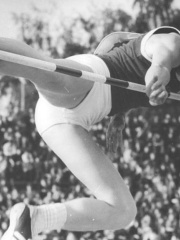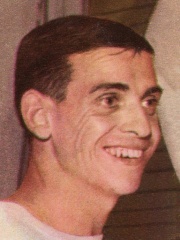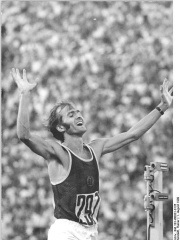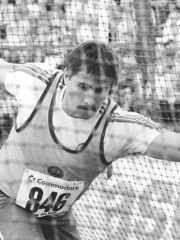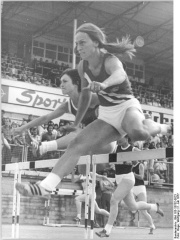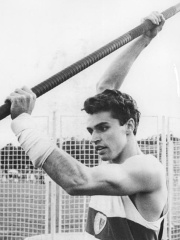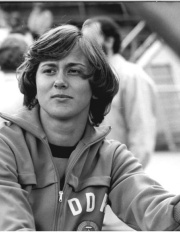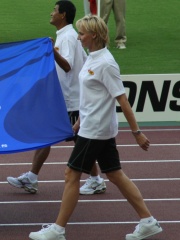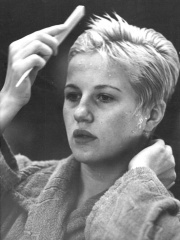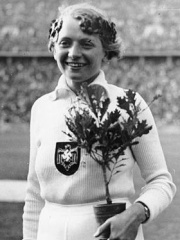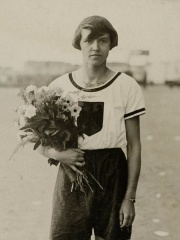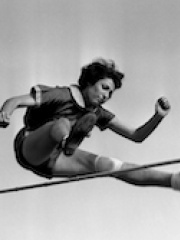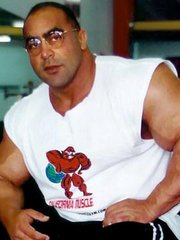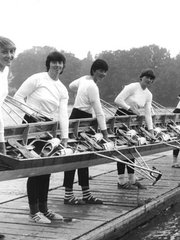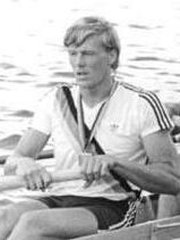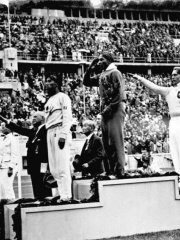
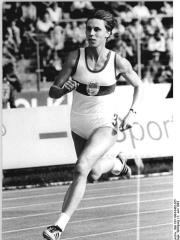
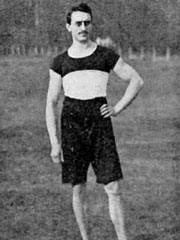
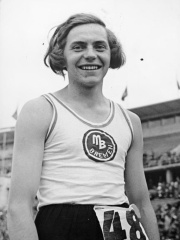

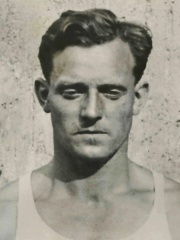
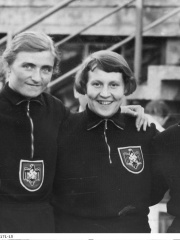
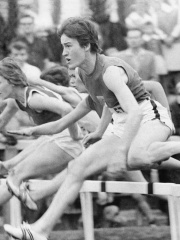
The Most Famous
ATHLETES from Germany
Top 10
The following people are considered by Pantheon to be the top 10 most legendary German Athletes of all time. This list of famous German Athletes is sorted by HPI (Historical Popularity Index), a metric that aggregates information on a biography's online popularity. Visit the rankings page to view the entire list of German Athletes.

1. Luz Long (1913 - 1943)
With an HPI of 66.63, Luz Long is the most famous German Athlete. His biography has been translated into 28 different languages on wikipedia.
Carl Ludwig "Luz" Long (27 April 1913 – 14 July 1943) was a German Olympic long jumper who won the silver medal in the event at the 1936 Summer Olympics in Berlin and had a friendship with Jesse Owens, who won the gold medal in that event. Luz Long won the German long jump championship six times: in 1933, 1934, 1936, 1937, 1938, and 1939. Long was killed while serving in the German Army under the Wehrmacht during World War II.

2. Marita Koch (b. 1957)
With an HPI of 65.40, Marita Koch is the 2nd most famous German Athlete. Her biography has been translated into 41 different languages.
Marita Koch (later Meier-Koch; born 18 February 1957) is a German former sprint track and field athlete. During her career she set 16 world records in outdoor sprints as well as 14 world records in indoor events. Her record of 47.60 in the 400 metres, set on 6 October 1985, still stands.

3. Fritz Hofmann (1871 - 1927)
With an HPI of 63.93, Fritz Hofmann is the 3rd most famous German Athlete. His biography has been translated into 29 different languages.
Friedrich Carl August "Fritz" Hofmann (born 19 June 1871 in Berlin, German Empire; died 14 July 1927 in Berlin, Weimar Republic) was a German athlete. He competed at the 1896 Summer Olympics in Athens.

4. Dora Ratjen (1918 - 2008)
With an HPI of 63.46, Dora Ratjen is the 4th most famous German Athlete. His biography has been translated into 19 different languages.
Heinrich Ratjen (20 November 1918 – 22 April 2008), born Dora Ratjen, was a German athlete who competed for Germany in the women's high jump at the 1936 Summer Olympics at Berlin, finishing fourth, but was later determined to be male and/or intersex. In some news reports, he was erroneously referred to as Hermann Ratjen and Horst Ratjen.
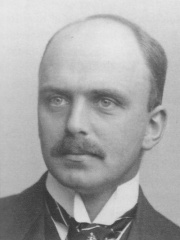
5. Friedrich Traun (1876 - 1908)
With an HPI of 62.88, Friedrich Traun is the 5th most famous German Athlete. His biography has been translated into 28 different languages.
Friedrich Adolf "Fritz" Traun (29 March 1876 – 11 July 1908) was a German athlete and tennis player. Born into a wealthy family, he participated in the 1896 Summer Olympics and won a gold medal in men's doubles. He committed suicide after being accused of fathering a child out of wedlock.

6. Klaus Wolfermann (1946 - 2024)
With an HPI of 62.21, Klaus Wolfermann is the 6th most famous German Athlete. His biography has been translated into 28 different languages.
Klaus Wolfermann (German pronunciation: [klaʊs ˈvɔlfɐman] ; 31 March 1946 – 18 December 2024) was a German javelin thrower. He represented West Germany and won a gold medal at the 1972 Summer Olympics in Munich and set a world record in 1973. The javelin competition at the 1972 Games was the closest in Olympic history. Wolfermann had taken the lead from Jānis Lūsis of the USSR in the fifth round with an Olympic Record throw of 90.48 meters. Then, in the sixth and final round, Lūsis let fly with a very long effort that measured at 90.46 meters – Wolfermann's two centimeter margin was, at the time, the smallest unit of measurement used in javelin competitions. On 5 May 1973, Klaus Wolfermann set a new world record in the javelin throw, bettering Lūsis' previous record of 93.80 meters with a mark of 94.08 m. Wolfermann's record stood until 26 July 1976, when Hungary's Miklós Németh threw his javelin for 94.58 m at the 1976 Summer Olympics in Montreal, Quebec, Canada. Wolfermann died on 18 December 2024, at the age of 78.

7. Karl Hein (1908 - 1982)
With an HPI of 61.93, Karl Hein is the 7th most famous German Athlete. His biography has been translated into 24 different languages.
Karl Hein (11 June 1908 – 10 July 1982) was a German hammer thrower who won a gold medal at the 1936 Summer Olympics.

8. Gisela Mauermayer (1913 - 1995)
With an HPI of 61.84, Gisela Mauermayer is the 8th most famous German Athlete. Her biography has been translated into 24 different languages.
Gisela Mauermayer (24 November 1913 – 9 January 1995) was a German athlete who competed mainly in the discus. She won the gold medal at the 1936 Summer Olympics held in Berlin, Germany.

9. Karin Balzer (1938 - 2019)
With an HPI of 61.20, Karin Balzer is the 9th most famous German Athlete. Her biography has been translated into 26 different languages.
Karin Balzer (née Richert; 5 June 1938 – 17 December 2019) was an East German hurdler who competed in the 80 m hurdles event at the 1960, 1964 and 1968 Olympics, and in the 100 m hurdles in 1972. She won a gold medal in 1964 and a bronze in 1972, while finishing fifth in 1968. During her career she set 37 world's best performances.
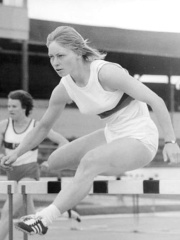
10. Annelie Ehrhardt (1950 - 2024)
With an HPI of 61.15, Annelie Ehrhardt is the 10th most famous German Athlete. Her biography has been translated into 28 different languages.
Annelie Ehrhardt (née Jahns; 18 June 1950 – 18 October 2024) was an East German hurdler. She won the gold medal in the inaugural 100 metre hurdles event at the 1972 Summer Olympics held in Munich, West Germany, setting a new world record, and becoming the first East German Olympic Champion in this event. She also won a silver medal at the 1971 European Championships and a gold medal at the 1974 European Championships in a new championship record of 12.66 seconds. Born Annelie Jahns, she married Olympic sprint canoer Manfred Ehrhardt in 1970 and became known under her married name. During her career Ehrhardt won 11 national titles and set 20 world records over various hurdle distances, indoors and outdoors. She was a photo laboratory assistant by profession. Ehrhardt died in Magdeburg on 18 October 2024, at the age of 74.
People
Pantheon has 972 people classified as German athletes born between 1808 and 2007. Of these 972, 843 (86.73%) of them are still alive today. The most famous living German athletes include Marita Koch, Rosemarie Ackermann, and Armin Hary. The most famous deceased German athletes include Luz Long, Fritz Hofmann, and Dora Ratjen. As of April 2024, 165 new German athletes have been added to Pantheon including Nasser El Sonbaty, Carsten Bunk, and Andreas Knebel.
Living German Athletes
Go to all RankingsMarita Koch
1957 - Present
HPI: 65.40
Rosemarie Ackermann
1952 - Present
HPI: 60.55
Armin Hary
1937 - Present
HPI: 60.53
Waldemar Cierpinski
1950 - Present
HPI: 60.24
Jürgen Schult
1960 - Present
HPI: 59.57
Johanna Klier
1952 - Present
HPI: 58.35
Wolfgang Nordwig
1943 - Present
HPI: 58.19
Renate Stecher
1950 - Present
HPI: 58.08
Monika Zehrt
1952 - Present
HPI: 57.65
Marlies Göhr
1958 - Present
HPI: 57.55
Heike Drechsler
1964 - Present
HPI: 57.53
Ingrid Gulbin
1943 - Present
HPI: 57.39
Deceased German Athletes
Go to all RankingsLuz Long
1913 - 1943
HPI: 66.63
Fritz Hofmann
1871 - 1927
HPI: 63.93
Dora Ratjen
1918 - 2008
HPI: 63.46
Friedrich Traun
1876 - 1908
HPI: 62.88
Klaus Wolfermann
1946 - 2024
HPI: 62.21
Karl Hein
1908 - 1982
HPI: 61.93
Gisela Mauermayer
1913 - 1995
HPI: 61.84
Karin Balzer
1938 - 2019
HPI: 61.20
Annelie Ehrhardt
1950 - 2024
HPI: 61.15
Tilly Fleischer
1911 - 2005
HPI: 60.71
Lina Radke
1903 - 1983
HPI: 60.48
Gretel Bergmann
1914 - 2017
HPI: 60.18
Newly Added German Athletes (2025)
Go to all RankingsNasser El Sonbaty
1965 - 2013
HPI: 54.10
Carsten Bunk
1960 - Present
HPI: 50.25
Andreas Knebel
1960 - Present
HPI: 49.08
Barbara Mensing
1960 - Present
HPI: 48.92
Ellen Becker
1960 - Present
HPI: 48.82
Kirsten Wenzel
1961 - Present
HPI: 48.75
Jutta Ploch
1960 - Present
HPI: 48.65
Carola Hornig
1962 - Present
HPI: 48.33
Uwe Proske
1961 - Present
HPI: 48.09
Roland Schröder
1962 - Present
HPI: 48.06
Karsten Schmeling
1962 - Present
HPI: 47.78
Udo Wagner
1963 - Present
HPI: 47.68
Overlapping Lives
Which Athletes were alive at the same time? This visualization shows the lifespans of the 25 most globally memorable Athletes since 1700.

